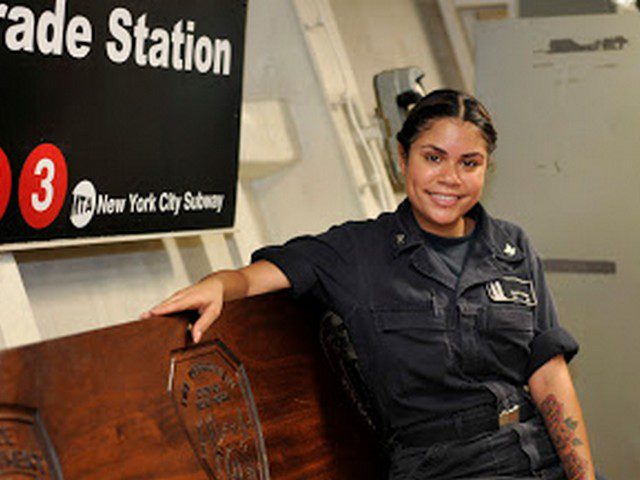
(Photo by Mass Communication Specialist First Class Robert Zhan)
As the nation recently observed the 16th anniversary of the terrorist attacks of Sept. 11, 2001, a Miami native is serving in the U.S. Navy aboard a ship built using steel from the World Trade Center.
Petty Officer Third Class Delana Harrison is a hull maintenance technician aboard USS New York responsible for repairing and upkeep of vital ship systems. USS New York, one of the Navy’s newest and most advanced amphibious ships, is designed to deliver Marines and their equipment where they are needed to support a variety of missions ranging from amphibious assaults to humanitarian relief efforts.
“Serving onboard the New York is surreal,” Harrison said. “Some days I walk up to the ship and I say ‘wow, I’m in the Navy.’ It is a reality check sometimes.”
Homeported in Mayport, FL, USS New York, named for the state of New York, is longer than two football fields at 684 feet, is 105 feet wide and weighs more than 24,000 tons. It has four diesel engines that can push the ship through the water in excess of 26 mph.
According to the Navy, New York’s bow, forged from steel salvaged from the wreckage of the 9/11 World Trade Center attack, embodies the strength and determination of the people of the United States to recover, rally, and take the fight to the enemy and honor the memory of those who were affected by the attacks. USS New York forges an enduring alliance between the people of New York, the ship, and her crew.
Serving in the Navy and aboard New York, Harrison is constantly learning how to be the best leader, sailor and person possible by handling numerous responsibilities, meeting deadlines, and forging lasting professional relationships.
Sailors’ jobs are highly varied aboard USS New York. More than 400 men and women make up the crew, which keeps all parts of the ship running smoothly, from washing dishes and preparing meals to handling weaponry and maintaining the engines. An additional 700 Marines can be embarked. New York is capable of transporting the Marines and landing them where they are needed via helicopters, vertical takeoff and landing aircraft and landing craft.
“It’s a ship like no other,” said Capt. Todd Vandegrift, commanding officer, USS New York. “It represents the fighting spirit and resiliency of our Navy and nation. While 9/11 maybe a distant memory for many, the events of that day are ever present before the crew and they shape the service and performance of each sailor.
“The USS New York is at the forefront of readiness, amphibious operations and warfighting innovation. From being the ship of choice for the most demanding mission, to the highest scores in the amphibious transport dock (LPD) fleet during the USS New York’s recent Board of Inspection and Survey Inspections Material Condition Inspection, this ship and its crew leads the LPD fleet,” Capt. Vandegrift added.
“It’s an honor and a privilege to be able to help guide and mold these young men and women’s futures.”
Collectively, the San Antonio-class ships will functionally replace more than 41 ships providing the Navy and Marine Corps with modern sea-based platforms. Amphibious transport dock ships are warships that embark, transport, and land elements of a landing force for a variety of expeditionary warfare missions.
These ships support amphibious assault, special operations or expeditionary warfare missions and can serve as secondary aviation platforms for amphibious ready groups. Because of their inherent capabilities, these ships have been and will continue to be called upon to support humanitarian and other contingency missions on short notice as well.
As a member of one of the U.S. Navy’s high-tech amphibious assault ships, Harrison and other New York sailors are proud to part of a warfighting team that embodies the spirit, strength and resilience of the American people.
“Serving, to me, is more than just saying I’m in the military,” Harrison said. “There is more to it than just war. It’s a different mission everyday and the job is never done.”






